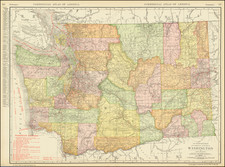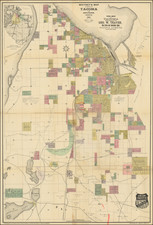Petermann's map provides a detailed representation of the San Juan or Haro Islands following the 1872 arbitration by the German Emperor. It covers a wide area, extending north to the Gulf of Georgia, west to Vancouver, east to Bellingham Bay, and south to Port Angeles on the Strait of San Juan de Fuca, with the San Juan or Haro Archipelago positioned centrally.
Maritime features are prominent on the map, with depths indicated through soundings, potential navigation hazards like shallows marked, and the various islands within the archipelago clearly outlined.
A significant feature of the map is the boundary between Canada and the US. This demarcation has its roots in the ambiguous wording of the 1846 Oregon Treaty, which led to both the US and Britain laying claim to the San Juan Islands. The tension culminated in the "Pig War" of 1859, a dispute over the killing of a pig that saw both British and American troops in a standoff on the island.
To resolve this territorial disagreement, international arbitration was sought. Kaiser Wilhelm I of Germany was chosen as the neutral arbitrator. After reviewing evidence from both parties, his decision in 1872 awarded the San Juan Islands to the United States, establishing the boundary depicted on this map.
August Heinrich Petermann (1822-1878) is a renowned German cartographer of the nineteenth century. Petermann studied cartography at the Geographical Art-School in Potsdam before traveling to Edinburgh to work with Dr. A. Keith Johnston on an English edition of Berghaus’ Physical Atlas. Two years later he moved to London, where he made maps and advised exploratory expeditions as they set off to explore the interior of Africa and the Arctic.
In 1854, Petermann returned to Germany to be Director of the Geographical Institute of Justus Perthes in Gotha. There, he was the editor of the Geographische Mittheilungen and Stieler’s Handatlas. The Royal Geographical Society of London awarded him their Gold Medal in 1860. He continued his interest in exploration in Germany, fundraising for the German Exploring Expeditions of 1868 and 1869-70, which sought an open Arctic sea. Tragically, he committed suicide in 1878.









![[Columbia Basin Irrigation Project] Panoramic Perspective of the Spokane Region including the Geological and Scenic Wonderland Embracing the Columbia Basin Irrigation Project and Coulee Dam . . . 1946](https://storage.googleapis.com/raremaps/img/small/77423.jpg)

![[ North Fork Snoqualmie River -- Calligan Lake ] Township No. 25 North, Range No. 9 East.](https://storage.googleapis.com/raremaps/img/small/101663.jpg)
![[ Early Automobile Tourism -- Pacific Coast Highways ] (Strip Maps, etc.)](https://storage.googleapis.com/raremaps/img/small/81461.jpg)

